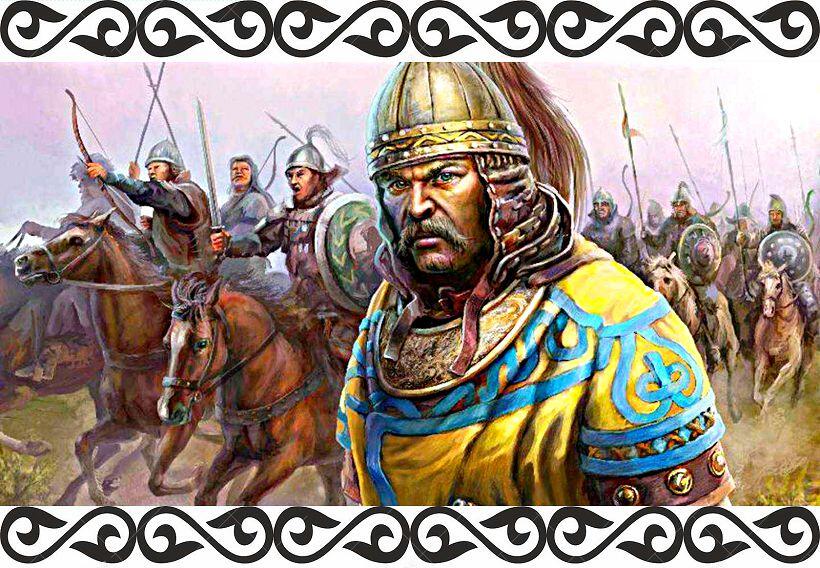The Kipchaks are a tribe of warriors who have forever migrated and disappeared
According to Chinese sources, the earliest Kipchaks — Sars, Shars, Xueyanto — «yellow-headed», roamed in the IV-VII centuries in the steppes between the Mongol Altai and the eastern Tien Shan. They were named among 15 Uighur tribes.
According to the Muslim geographer of Iranian origin Ibn Khordadbeh, who lived from 820 to 913, in his «Book of Ways and Countries» (847. ) states that the Kipchaks, along with the Kimaks, Guzes, Chigils, Türgeshs, Azkishs, Karluks, Khalajs, and Kirghiz, who have musk, are inhabitants of «the country of the Tuguzguz Turks, the most extensive of the Turkic countries, which borders on as-Sin and at-Tubbat.» [Ibn Khordadbeh. The book of ways and countries // Per. from Arabic, commentary, research, index and maps by N. Velikhanova; Academy of Sciences of the Azerbaijan SSR, Institute of Oriental Studies. — Baku: Elm, 1986. — С. 66].
In the «Collection of Chronicles» — a historical work in Persian language, compiled in the early XIV century by the vizier of the Hulaguid state Rashid ad-Din on the orders of the Mongol Ilkhan of Iran Gazan Khan (1271-1304) from the Hulaguid dynasty, it is said that the Kipchaks were one of 24 Oghuz tribes.
Thus, traces of the earliest Kipchaks are lost in various Turkic «yellow-headed» tribes of the «country of the Turks-Tuguzguzes» and most likely they, because of their large number, dominance and intensity of ethnic processes, were the nucleus of various Turkic tribes of that time, which either feuded with each other or entered into alliance relations, but all of them were related to each other. Therefore, the Kipchaks should be considered as integral residents of various Turkic Kaganates, which succeeded each other on the historical arena first in Eastern and then in Central Asia.
All these processes, in their early period, took place in the vast territories of South Siberia, Mongol Altai, Baikal, eastern Mongolia, up to the borders of China (Sui, Tang, Song, Liao empires). These territories were the original settlement area of numerous Turkic tribes of that time. Intensive historical processes and ethnogenesis of various Turkic tribes took place on these territories with their participation.
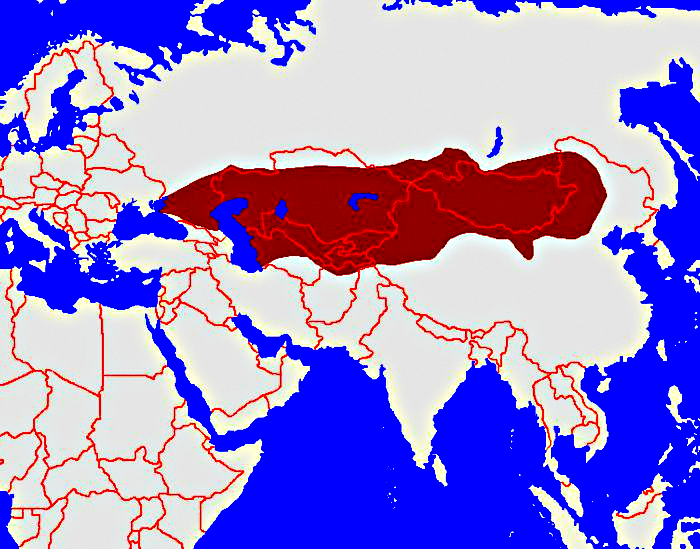
The Turkic Kaganate is one of the largest states in the history of Asia, created by a tribal association of ancient Turks headed by rulers from the Ashin family. In the period of the greatest expansion (the end of VI century) controlled territories of Manchuria, Mongolia, Altai, East Turkestan, West Turkestan (Central Asia), Kazakhstan, and also Crimea and Northern Caucasus. In 542 the ethnonym «Turks» for the first time occurs in Chinese sources.
History of Turkic Khaganates
On these territories in 603 because of internal feuds of Turks there was a disintegration of Turkic Khaganate on the Western and Eastern. The Eastern Khaganate had common long borders with China and had frequent wars with this state, defending the independence.
In 630 the Eastern Khaganate still fell after invasion of well prepared and organized armies of the Chinese empire Tang. Türks have rolled back to the West, but having collected with forces have revolted against Chinese, and again have occupied the earlier lost territories of nomads in the East. Historians called this period the time of existence of the so-called Second Eastern Turkic Kaganate (Kok-Turkic Kaganate) — a medieval ancient Turkic state that existed from 682 to 744.
Then the area of nomadic eastern Turks — Kipchaks stretched across the territory of Mongolia with the center in Otyuken on the bank of the river Orkhon. The Kipchak Turks dominated this territory over other Turkic tribes, including the Uyghurs, who had a written language.
The earliest mention of the ethnonym «Kipchak» in these lands was found in an ancient Uyghur inscription inscribed on a stone stele dated 760, discovered by Ramsted in Central Mongolia south of the Selenga River in 1909. In literature this epitaph has been called the Selenga Stone.

A memorial complex in honor of Il Yetmish Bilge kagan who ruled in 747-759 (in Chinese sources: Gale-khan Moyanchjo (Moyun-chur, Bayan-chur). It is located in the area of Mogoin shine us somon Saikhan of Bulgan aimag of Mongolia. To date, the monument is located at the site of discovery. The monument complex consists of a stele, its pedestal in the form of a turtle. The stele is made of granite, 50 lines of inscription are carved on all 4 sides. The first research was carried out in 1909 by G.I. Ramstedt, the head of the expedition of the Finnish-Ugric Scientific Council, who called it «Selenginsky Stone», and also published a study of the inscriptions of the stele.
The text carved on it is part of the funerary complex of Bilge-Kagan (747-759), one of the founders of the Eastern Turkic Kaganate in the Mongolian steppes. In the fourth line on the north side of the stele, the Uyghurs have carved: «When the Kipchak Turks ruled over us for 50 years…».
Uigur Kaganate
In the middle of the VIII century the Kipchak Kaganate (Second Eastern Turkic Kaganate) as a result of internal weakening due to internecine strife and exodus was defeated by the Uyghurs, which led to a mass migration of Kipchaks to the west, to the drier steppes of northern Kazakhstan, to the upper reaches of the Irtysh and the steppes adjacent to the territory of Russia (Eurasian steppe).
According to one version, the name «Kipchaks» was given to them by the Uighurs, and it can be translated as «exiles», «fugitives», or even «ill-fated». It was originally used by the neighbors of these nomads. They called themselves according to their belonging to this or that tribe.
According to one version, the name «Kipchaks» was given to them by the Uighurs, and it can be translated as «exiles», «fugitives», or even «ill-fated». It was originally used by the neighbors of these nomads. They called themselves according to their belonging to one or another tribe.
Having expelled the Kipchaks, the Uyghurs settled on the territory of present-day Tuva, Mongolia, up to the lands of the middle reaches of the Amur River and the lands of present-day Inner Mongolia.
Ibn Khordadbeh mentions the lands of the Uyghurs (Tokuz-oguz): «Their area is the largest of the Turkic countries, they border China, Tibet and the Karluks».
The Uigur Khaganate existed from 744 to 840.
Kyrgyz Kaganate
In 840 the Yenisei Kyrgyz, attacking in a powerful wave from the north, defeated the Uigur Kaganate and burned its capital Khara-Balgas. The Kyrgyz extended their power to Tuva and Mongolia.
In 847 the Kyrgyz, carried away by victories and pursuing the Uighurs, made a campaign to the Amur, at the same time the Chinese, concerned about new movements of barbarians at their borders, advanced to meet them. The Uyghurs, who were caught in a vise, broke through the corridor between the Kyrgyz and the Chinese and fled to East Turkestan.
Thus, the Uigur Kaganate was knocked out by the Kyrgyz Kaganate, a state of the Yenisei Kyrgyz, originally founded by the Kyrgyz leader Barsbek Kagan and existing between the 6th and 10th centuries.
Having defeated the Uighurs, the Kyrgyz were content with the forest-steppe territories of southern Siberia and northwestern Mongolia, but during the period of their power the Kyrgyz did not dare to invade the open areas of the Eastern Steppe, which extended to the borders of China. The warlike Mongolian-speaking steppe tribes lived there.
From 840 to 925, the Kyrgyz Kaganate was at the peak of its power and extended to the eastern Tien Shan. This period of history V. V. Bartold called «Kyrgyz great power».
Expansion of Mongol-speaking tribes. The first Mongol expansion of the X-XI centuries
Meanwhile, in the 10th century, nomadic Mongol tribes, originally inhabiting the Amur River basin, the Onon River, the south of Transbaikalia, Manchuria, Inner and Eastern Mongolia, strengthened their influence in the Eastern Steppe. They unite in powerful tribal unions by anthropological and linguistic kinship and begin to gradually displace from the territory of Mongolia «yellow-headed» (Shars) — Turkic tribes of Kyrgyz, Uigurs and remnants of Kipchaks tribes to the west.
At the same time Mongolian-speaking nomads — Kidans and other related tribes unite in the Kidan state Liao, which existed from 907 to 1125.
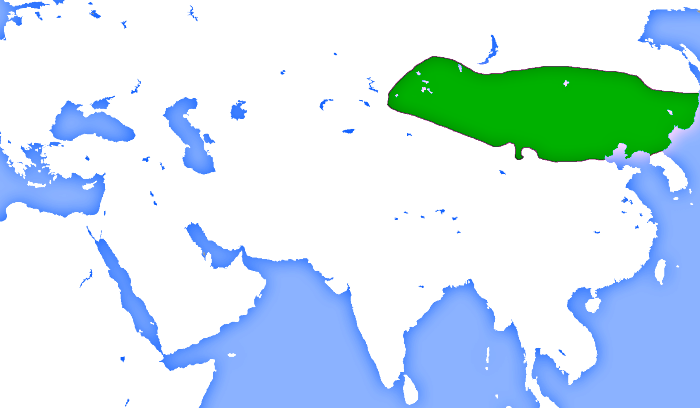
the Khitan Empire
The state of the Kidans occupied the expanses of Northeast China and due to its intelligence and passionarity became the most powerful power in East Asia.
Kidanes together with other Mongolian-speaking tribes on a systematic basis began to displace «yellow-headed» from the territory of Mongolia, Transbaikalia and Pribaikalia. By the end of X century the territory of the Kyrgyz Kaganate was reduced to the valley of the river Yenisei, as well as Altai, with the capital in Kemidzhket.
At the beginning of the XI century, the powerful formerly Kyrgyz Kaganate fell under the onslaught of warlike Mongolian-speaking tribes, and the Kyrgyz were forced to retreat to their native taiga expanses of southern Siberia. And the Kidan state stretched from the Sea of Japan to Eastern Turkestan.
Kipchaks in the new homeland. The Golden Age of the Kipchaks (IX-XII cc.)
Since the IX century Kipchaks are known according to the works of Arab-Persian authors in the territory of modern north-western Kazakhstan in the Kimak Kaganate, bordering in the east with the Kimaks, in the south with the Karakhanids and in the west with the Khazars.
At the end of IX century on the territory of modern Kazakhstan and Southern Siberia there was an association of Oguzes (Guzes) headed by Kimaks, known as Kimak Kaganate. The capital of the state was the city of Imakia on the Irtysh. At the turn of IX-X centuries it extended from Irtysh to Volga.
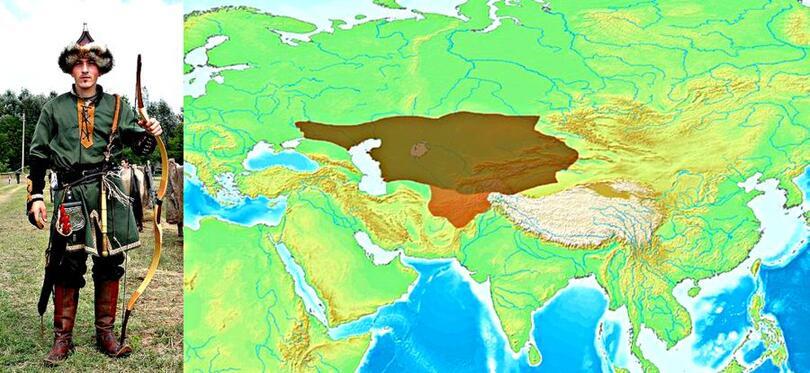
After the collapse of the Uigur Kaganate in 840, a large number of eastern Turkic tribes, including the Kipchaks, joined the Kimaks.
In the middle of the 10th century in Semirechye (in Zhetysu and part of East Turkestan), in close proximity to the Kimaks, the Karakhanid state was established. The capital was the city of Balasagun. The ethnic composition of the Karakhanid state included the tribes of Zhikil, Yagma, Karluk, Oguz, Kanl, Uysun and other Turkic-speaking tribes. In the northeast of it are grouped tribal unions of Kipchaks — refugees from the Eastern Steppes, persecuted as a result of the expansion of Uighurs, Kirghiz, and later Mongol-speaking tribes.
The Kipchaks did not become part of the Karakhanid state, but they created an external threat and increased separatism within the neighboring Kimak Kaganate. Eventually the new guests led to the disintegration of the Kimak Kaganate. By the middle of the X century, the strongest in the struggle for hegemony in the steppe were the Kipchaks, by the ethnonym of which the steppe north of the Syr Darya in the Eastern sources since 1030 began to be called Kipchak (Pers. «Desht-i Kipchak»).
At the beginning of the XI century Kipchaks came close to the north-eastern borders of Khorezm, displacing the Oguzes from the lower reaches of the Syr Darya and forcing them to move to Central Asia and the steppes of the Northern Black Sea coast.
By the middle of XI century Kipchaks subordinated almost all vast territory of Kazakhstan, except Semirechye. Their eastern border remained on the Irtysh, their western limits reached the Volga, in the south — the Talas River area, and the northern border was the forests of Western Siberia. Eventually the Kipchaks settled the expanses of the steppe from the Irtysh to the Danube. This was the golden age of the Kipchaks.
In the second half of the XI century written sources of the neighboring countries with the Northern Black Sea coast recorded new names of steppe nomadic tribes — Polovtsy, Kumans, Kuns. What are these tribes? Where did they come from? To some extent, the answer to these questions is given by the medieval researcher Tahir al-Marwazi (1057-1125). In one of his works (1120) he stated some information about important events that took place in the XI century — the mass migration of nomads of the eastern steppes to the west.
The Kipchaks did not create a state within the framework of which a single ethnic community could be formed. Mahmud al-Kashgari named the Kipchaks among the tribes that spoke the western dialect of the Old Turkic language, noting the closeness of the Kipchak and Oguz dialects [4, p. 52].
Mongol expansion of the 12th-13th centuries.
During the period of continuing passionary upsurge in the late XII early XIII centuries. Mongols consistently conquered at first the nearest neighbors (Tanguts, Uighurs, Kipchaks), and in 1209 defeated the Kyrgyz Kaganate. Then the turn came to Naimans, Sogdians, Karakhanids, Khorezmians, and Tajiks. Having been defeated by the Mongols, they became their subjects and further participated in the campaigns of Genghis Khan and his descendants. Simultaneously or immediately after it Mongols have subordinated to itself China (where have created new dynasty Yuan), Central Asia, Russia, the Near East and Front Asia.
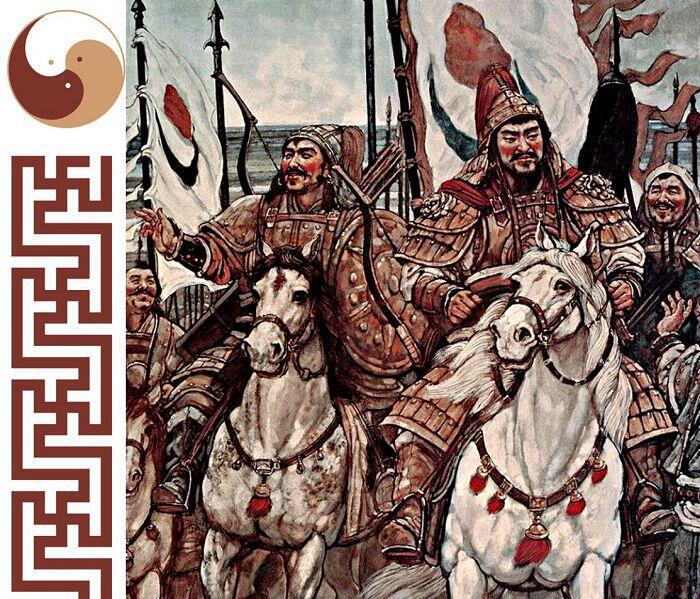
When from the Mongol steppe to the expanses of Eurasia came the conquerors led by Genghis Khan and his sons, of all the Turkic-speaking peoples it was the Kipchaks who offered them the most fierce resistance. The Mongols were amazed by the steadfastness of this people and pursued them to the end. Part of the conquered Kipchaks joined the ulus of Genghis Khan’s eldest son Dzhuchi (Golden Horde), and the other scattered across Eurasia, fled to Europe, particularly Hungary, where their descendants still live. Kipchaks even reached Egypt. The representative of this people was the famous Sultan Beibars. The Kipchaks also made up the majority of the Mamluks’ formations — warrior-slaves, famous for their bravery.
The Mongol invasion involved many Turkic tribes, mainly Kipchak tribes, which constituted the main population of the steppe — from the Great Wall of China to the Danube — in the vortex of political upheavals [Klyashtorny and Sultanov 2004].
The era of Mongol conquests of the 13th-14th centuries led to a period of large-scale changes in the ethnic structure of the once distinctive and diverse Turkic-speaking tribes. New mixed Turkic-Mongolian ethnic groups appeared in the territories of the Ulus Dzhuchi and Chagatai. This period was particularly difficult for the Turks. Some tribes were defeated and disappeared from the face of the earth, others went to distant lands, others united among themselves. In these conditions there was a gradual convergence and formation of new local Turkic-speaking tribes and clans, various ethnic formations appeared in the new ulus system.
However, the mighty Mongolian super-ethnos, like many other ethnic systems before it, could not withstand the colossal passionary overheating and gradually began to collapse on its vast possessions, surrounded by representatives of other ethno-cultural environment, much exceeding it in number. Together with it the socio-political forms-states also fell apart. The norms of Genghis Khan’s Yasa began to weaken under the pressure of Muslim norms of sedentary peoples. The Golden Horde, the largest state formation in the Mongol Empire, by the middle of the 15th century had actually disintegrated into a number of independent khanates, which became the basis for the formation of new ethnic systems.
The disintegration of the Golden Horde into separate khanates determined the incorporation of the Kipchaks into different, although close ethnic groups, but already as sub-ethnic groups.
It is characteristic that in the list of tribes of Desht-i Kipchak, given in the works of Arab-Persian authors of XII-XIV centuries (during the Mongol conquests), the ethnos with the name «Kipchak» is already absent.
In this scorcher of expansion and then collapse of the Mongol Empire lies the disappearance of the Kipchaks and the beginning of many modern Turkic ethnoses, which absorbed the traditions and experience of Mongolian ethnogenesis.
The Arab Muslim philosopher and historian Ibn Khaldun (1332-1406), listing 11 tribes of Desht-i Kipchak in his work of 1400, wrote that all these tribes were «not of one kind», i.e. ethnically heterogeneous. Among the (ethnic) Kypchaks themselves, the sources mention only a few main tribes, whose khans had territorial possessions (Uran on the Syr Darya, Elbori in the Southern Urals).
Genotype, appearance and language of the Kipchaks
Scientists believe that the original Kipchak haplogroup is R1a. After the Mongol invasion, the Kipchaks of Central Asia also acquired haplogroup C2a1.
The greatest distribution R1a has in Central and South Asia, in Central and Eastern Europe. Haplogroup C2a1 is now traced in some Central Asian clans under the name Kypchak. Nevertheless, unequivocally to answer a question on an ethnic cut concerning Kipchaks hardly it is possible, in fact in fact because of a current migration, and also constant military conflicts and Mongol expansion there was a constant mixing of bloods.
In Russia Kipchaks were called Polovtsians. According to the most widespread and reliable version, they were called so because of their characteristic straw-yellow hair color (from the word «polova» — straw). It is believed that together with the Kipchaks some tribes of Kimaks came to the Black Sea steppes.
Modern studies have shown that the Kipchaks (Polovtsians) were representatives of the Caucasoid race. Probably, therefore, unlike Mongols, they were not perceived by Russians as descendants from Tartarus.
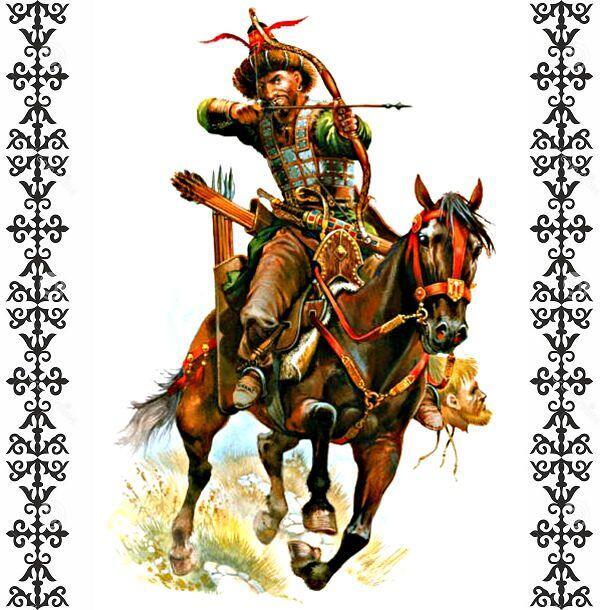
According to surviving Arabic, Byzantine Russian and Western sources, it is known that this people spoke the Turkic language.
Today the group of Turkic languages can be divided into six groups. They, from the East to Asia Minor, are located in the following regions:
1. Volga-Ural region (Tatars, Bashkirs, Chuvash, Crimean Tatars);
2. Caucasian foothills (Azerbaijanis, Balkars, Karachais, Nogais);
3. Turan Lowland (Kazakhs, Karakalpaks, Kyrgyz, Uzbeks, Turkmen);
4. Eastern Turkestan (Uighurs);
5. Western and Eastern Siberia (Altai, Khakass, Chulym, Shorians, Teleuts, Kumandins of the Northern Altai, Altai Kirghiz, Tuvinians, Tofalars, Sakha-Yakuts);
6. Asia Minor (Turks).
It is believed that the Kipchaks influenced the formation of these different peoples.
At the same time, researchers note that in the Kipchak group of languages there is a strong Oghuz influence and this throws a kind of «bridge» to the modern Turkish language. At the same time, it is assumed that the Kipchaks had a great influence on the formation of the Tatar ethnos. Their influence is most clearly felt on the Mishar Tatars, among whom there are several different anthropological types, including fair-haired and light-eyed. This is what Arab sources claim the Kipchaks looked like. The tsk tsk talk of some Misharis is also a legacy of the Kipchaks. In any case, words similar in pronunciation are found in the famous «Codex Cumanicus», a dictionary of the Kipchak language compiled by Catholic missionaries to preach Christianity in the Golden Horde.
By religion, the Kipchaks were pagans and worshipped stone statues of Balbal, but during the Golden Horde their overwhelming majority living in the territory of the Horde adopted Islam.
The Kipchaks dissolved in the Great Steppe, the masters of which they were from the XI to the XIII centuries, but their traces remained in those peoples whose progenitors they are.
